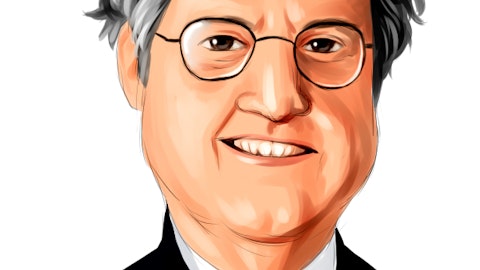Vincent Caintic: I want to dig into the front — that front book and back book dynamic in more detail. The — so with 13 months having passed since the — since that August 22 update. I guess the losses that we’re seeing implied in the fourth quarter net charge-offs, is that I guess, being driven by the loss of merchants since we’re kind of in the meat of that what would typically happen with a kind of a 12-month loss emerging cycle? And then is there a way to break out sort of how you’re thinking about a credit allowance for your blended portfolio, so you have that versus like once you’re — once the book is primarily the new originations, the front book originations.
Micah Conrad: Let me try to unpack that a little bit, Vincent. This is Micah. I think the fourth quarter losses are going to come from 30 to 89 delinquency that happened in the second quarter. Our third quarter losses are going to come from 30 to 89 that occurred in the first quarter of this year. So, the vast majority of that 30 to 89 emerging to loss now and in the fourth quarter will have come from a lot of pre tightening vintages. It just takes some time for those — particularly for losses for the new book to become a larger part of that; so that’s piece one. I think you asked about just sort of the front and back book in terms of reserves and losses. I think in terms of the reserves. We’ve got a reserve model that really is focused and built around delinquency buckets.
So while our vintages are certainly a part of that, we use vintages for back testing and model validation, not necessarily building the model directly from those vintage expectations. But what we do in our reserving is largely, we look at delinquency buckets and we look at the roll rates historically and the expected roll rates and performance of those delinquency buckets as they emerge into loss, by virtue of the front book becoming a larger part of the portfolio. We, of course, will see those have a lower level of delinquency as we’ve called out, so that will influence our loss reserves. And again, on the back book, with the back book being very seasoned with a higher level of delinquency than that front book we’re going to have naturally higher reserves on that book because of the delinquent stock.
And so the two things are kind of right now sort of mixing into our reserves. And of course, we also have macro overlays in there, as we’ve talked about before, with expected unemployment 4.5% to 5%. So we would expect to see as the front book becomes a larger part of the portfolio, those reserves will start to be impacted more so by that front book as time goes on. Did I — I think you had a third question in there? Did I hit what you were looking for?
Vincent Caintic: Yes, I think that’s — I mean, I guess, presumably, the mid-2024 with the front book being 75% of that, that all else equal, the reserve freight would be lower at that time. Is sort of how we’re interpreting that because of lower losses and lower delinquencies and/or losses with the front book.
Micah Conrad: Yes. I mean I think it’s a decent general expectation. There’s a lot of things that will go on between now in the middle of 2024 with the macro environment, we got to see how the back book continues to perform and does the front book continue to perform where we expected to be. So a lot out there. I don’t want to commit to any particular number but I think your hypothesis is sound.
Vincent Caintic: Great. Very helpful. And second question separately on the auto purchase lending program that’s $650 million. So it’s good to see the growth there. I know broadly, with the pure auto lenders that I cover, it’s been sort of volatile in some banks, for instance, FX into that space and just volatility there. And so I’m wondering if you could talk about your thoughts about that market and the opportunities that you’re seeing where you can beat in and grow that program.
Doug Shulman: Yes. No, thanks, Caintic. So I guess a couple of things. One is, we’ve been in the secured lending business for many, many years. About half of our book is secured by an auto, so we actually know the business of making loans against auto as a collateral, very well. We understand underwriting, pricing, perfecting a lean collateral management, all of those pieces. A few years ago, I mentioned we started to expand our secured distribution channels, mostly through dealer track which is we signed up to a platform that’s hooked into a lot of auto dealers they would send us potential loans to make for it in auto and we started to inch our way into the market which we viewed as just a separate distribution channel. When those auto potential loan for an auto purchase comes to us, we do a very similar disciplined underwriting that we do when we make an installment loan secured by an auto.
So first, we put the 30% extra stress on there. And so we’ve run a very tight credit box since August 2022. We also work very closely and directly with the customer. So we get on the phone with a customer we talk them through their loan, their loan size, what they can afford, what’s their net disposable income. And so we have a very hands-on approach similar to our core business. And as a result, because we are going slow, we have tight underwriting standards and we’re more hands-on in the lending process than your typical indirect auto lender, we’ve seen really good credit results. And so roughly, this is a $500 billion or $600 billion market and we’ve got under $1 billion of receivables. So there’s plenty of opportunity for us to — in a very slow, measured way add some portfolio growth through this channel with loans that we like a lot.
So we’re very bullish on it. We think it’s a great opportunity for us. but we’re also very cautious and disciplined in how we build this out.
Operator: Our next question will come from Arren [ph] with Citi.
Unidentified Analyst: I was just wondering if you could talk a little bit about the competitive environment. It had kind of moved in your favor when it was a little bit more difficult to finance. Are you still seeing a better inflow of opportunities relative to where you were a few quarters back?
Doug Shulman: Yes. Look, it remains a very constructive competitive environment for us. our strong balance sheet and our access to funding and having plenty of liquidity, so we can make the loans that meet our return profile clearly stands us in good stead. And I think the fact that we never had to pull out because of funding constraints and our consistency of our brand in the market for customers is an important part of that. As you’ve seen from our results, even with a much tighter credit posture than we had a year ago, we’re still having nice origination growth which speaks to a good competitive environment. We also have been able to take some pricing actions and we’re still able to book lower risk customers at a higher price.
And so we like the competitive environment different competitors ebb and flow, how much they’re in the market and we’ve got a pretty broad competitor set. And so competitors aren’t as funding constrained now as they were 16 months ago. But in general, it’s still a very constructive environment for us.
Unidentified Analyst: And on the flow sales that you make, are you still selling around $180 million a quarter? And what’s the demand for whole loans that you’re seeing right now?



